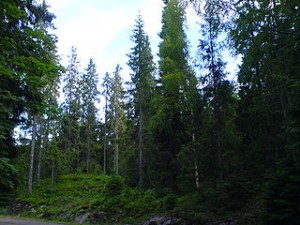The Fir and Falcon
The Fir and Falcon sounds like a good name for a medieval tavern. I can picture the large room with the riotous crowd, a bit too warm from the bodies and the fire in the hearth. The orange glow in the room flickers and dances in the torchlight even before the mead is poured. The patrons are mostly men, some with their wives or sweethearts, along with a few women of the sort men are happy to drink with but fear to meet on the battlefield. There is only one maid serving, and though her shoulders are broad and her arms strong from lifting innumerable tankards, she has a buxom figure, bright eyes, and lovely red lips that smile easily. She doesn’t mind the appreciative looks from the men, and she will laugh at a ribald joke, but none dare treat her with disrespect. Everyone knows they drink mead and eat boar in this hall at her pleasure. This is the Sessrymnir (SESS-rim-nir), “the roomy-seated hall,” home of the warriors who died most bravely, and it is the goddess Frejya who presides.Frejya (FRAY-yah or FRY-yah) leads the Valkyries (val-KEER-ease), the nine thin white-armed maidens who carry the dead from the battle fields, and she gets first choice of the slain heroes, a mark of her position in the warrior societies within Germanic cultures. There is much that we do not know about the mythology and magic of the non-warrior societies, particularly as they relate to women. Early recorders of Germanic mythology and tradition were mostly Norse Christians in the first centuries of conversion, who sought both to exalt these traditions and to reconcile them with Christian values of the time. Goddesses did not fare well in this context. Still, there is a larger medieval record of Freya than any other Germanic goddess. We know that the Summer Solstice was her biggest festival, and that on that evening many bonfires would be lit along the shoreline, simulating the special necklace she wore, the amber Brisingamen (BREE-sing-AH-men) necklace. We know that she was appealed to for good harvest, wealth, fertility and love. And we know that the tree she with which she was most closely associated was the fir; the animal, the boar; and the bird, the falcon.I need to digress here to explain something not generally understood about the Goddess in her biological forms. Many European goddesses have three manifestations, whether or not they are considered “triple goddesses.” (Semitic goddesses, on the other hand, usually have twin forms.) Take for example the goddess Athena. Robert Graves, recognizing Athena as a pre-Indo-European goddess despite the early Semitic influences on Greek culture, looked at two forms of Athena, the snake and the owl, and tried to find a third animal to complete the triad. He chose the goat for Athena’s third form, an association so tenuous and obscure only a scholar with his depth of knowledge could have found it. What Graves did not know, perhaps because his research centered on the Mediterranean, is that Old European goddesses have an earth animal form, a bird or sky animal form, and a tree form. This is what completes the triad. Knowing this we can immediately recognize Athena’s third form as the olive tree. It is represented on nearly all her coins, along with the owl. Cultivation of the olive tree was a huge achievement in agricultural production, and the owl and the snake also furthered agricultural production by keeping rodent populations in check. Looking at owl, snake and olive together backs up Graves’ assertion that Athena is primarily an agricultural goddess, and that her association with technology and highly organized society grew from that primitive role.So what does boar, fir and falcon say about Frejya? As this article is getting a bit long, the question will be explored in next week’s post.

